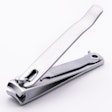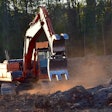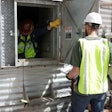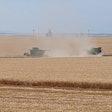
In Summer 2022, in one week, two people lost their lives in separate grain bin accidents, one in Minnesota and one in Georgia.
Storing and handling large volumes of grain carries risks to your employees. Increased storage capacities, larger and faster handling capacities, and automation contribute to many potentially hazardous situations during the storing of grain — and employees need to be aware of the inherent risks.
“The greatest challenge — and most important aspect — in keeping workers safe is establishing a safety culture in the workplace that views a task as complete only if it was done safely,” says Jess McCluer, vice president, Safety and Regulatory Affairs with National Grain and Feed Association.
“A successful safety culture is one in which workers do not even consider completing a task any other way, except for safely.”
Grain bin storage hazards
There are several hazards associated with grain storage bins, but the two most common are engulfment and entanglements. In this blog, we'll focus on entanglements.
Grain augers are one of the most dangerous pieces of equipment that your employees will work around. The primary danger in operating an auger is getting caught in a moving part, such as the flighting or power-take-off.
Grain bin entanglement hazards
Mechanical equipment within grain storage structures, such as augers and conveyors, present serious entanglement and amputation hazards.
Workers can easily get limbs caught in improperly guarded moving parts. Equipment used to fill and discharge grain storage structures needs to be properly guarded to prevent this.
Bin Sweep Augers: OSHA’s sweep auger policy memo states that employees are allowed to be physically inside a bin with an energized sweep auger provided:
- The only unguarded portion of the auger is in the front
- Sub-floor augers are guarded by secure grates or other guards
- There is an engineering control (such as a standard guardrail attached to the auger, a portable guard rail trailing seven feet behind the auger, or a dead man switch on an operating control inside an enclosure or attached to a handle that keeps the employee seven feet back from the auger)
- The facility’s bin-entry permit procedures are followed
Sub-Floor and Other Reclaim Augers: Sub-floor augers are to be locked out while an entrant is inside a bin, unless it is guarded and secured in such a way that removes the possibility of an employee encountering its moving parts. OSHA’s 1910.217 Subpart O provides guidelines for addressing other types of augers (such as semi-exposed sloped floor, mobile bin and truck-fill augers).
Belt and Chain/Paddle Drag Conveyors: These systems can be used as a fill or reclaim system. As a fill system, they should be included in the facility’s lockout/tagout program for bin entry since they have the potential to create hazardous conditions for workers when inside a bin. When these conveyances are used for reclaiming purposes, the same sub-floor guarding principles described above also apply.
Power Takeoff (PTO) Shafts: PTOs, unless properly guarded, can create wrapping hazards. These hazards could be caused by the joint, burrs or the air current formed by the rotation. To mitigate the hazard, install shaft guards that entirety cover the moving parts.
Workers should never step over a rotating shaft or operate controls from outside of the machine, never wear loose-fitting clothing, jewelry or hair, and stay clear of rotating PTO shafts.
Remember, human error or the willingness to take a chance to save time leads to most entanglement incidents.
“Engulfments and entanglements have one thing in common — they happen quickly,” reminds McCluer.
Find more bin site entanglement hazard tips or visit ngfa.org/safety for more safety tips.



















